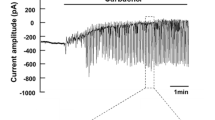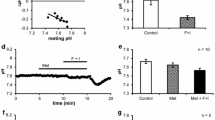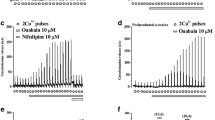Abstract
Previous studies have shown that the whole-cell current-voltage (I-V) relation of unstimulated sheep parotid cells is dominated by two K+ conductances, one outwardly and the other inwardly rectifying. We now show that once these K+ conductances are blocked by replacement of pipette K+ with Na+ and by the addition of 5 mmol/liter CsCl to the bath, there remains an outwardly rectifying conductance with a reversal potential of 0 mV. Replacement of 120 mmol/liter NaCl in the pipette solution with an equimolar amount of Na-glutamate shifted the reversal potential of this residual current to -55 mV, indicating that the conductance was Cl− selective. The Cl− current was activated by increasing the free Ca2+ in the pipette solution from 10 to 100 nmol/liter. When the Ca2+ concentration in the pipette solution was 10 nmol/liter, the relaxations observed in response to membrane depolarization could be fitted with a single exponential, whose time constant increased from 81 to 183 ms as the pipette potential was increased from -30 to +60 mV. Relaxation analysis showed that the current was activated by membrane depolarization. Reversal potential measurements in experiments in which external Cl− was replaced with various anions, gave the following relative permeabilities: SCN- (1.80) > I- (1.09) > CI- (1) > NO -3 (0.92) > Br- (0.75). The relative conductances were: SCN- (2.18) > I- (1.07) > Cl− (1.00) > Br- (0.91) > NO -3 (0.50). The Cl− current was blocked by NPPB (ID50 ≈ 10 μm), DIDS (10 or 30 μmol/liter) and furosemide (100 μmol/liter).
Similar content being viewed by others
References
Anderson, M.P., Welsh, M.J. 1991. Calcium and cAMP activate different chloride channels in the apical membrane of normal and cystic flbrosis epithelia. Proc. Natl. Acad. Sci. USA 88:6003–6007
Anderson, M.P., Gregory, R.J., Thompson, S., Souza, D.W., Paul, S., Mulligan, R.C., Smith, A.E., Welsh, M.J. 1991. Demonstration that CFTR is a chloride channel by alteration of its anion selectivity. Science 253:202–205
Barry, P.H., Lynch, J.W. 1991. Liquid junction potentials and small cell effects in patch-clamp analysis. J. Membrane Biol. 121:101–117
Compton, J.S., Nelson, J., Wright, R.D., Young, J.A. 1980. A micropuncture investigation of electrolyte transport in the parotid glands of sodium-replete and sodium-depleted sheep. J. Physiol. 309:429–446
Cook, D.I., Young, J.A. 1989. Fluid and electrolyte secretion by salivary glands. In: Handbook of Physiology. The Gastrointestinal System. Salivary, Pancreatic, Gastric and Hepatobilitary Secretion. J.G. Forte, editor. Section 6, vol III, pp. 1–23. American Physiological Society, Bethesda
Cook, D.I., Young, J.A. 1990. Cation channels and secretion. In: Epithelial Secretion of Water and Electrolytes. J.A. Young, P.Y.D. Wong, editors, pp. 15–38. Springer-Verlag, Heidelberg
Cook, D.I., Wegman, E.A., Ishikawa, T., Poronnik, P., Alien, D.G., Young, J.A. 1992. Tetraethylammonium blocks muscarinically evoked secretion in the sheep parotid gland by a mechanism additional to its blockade of BK channels. Pfluegers Arch. 420:167–171
Cunningham, S.A., Worrell, R.T., Benos, D.J., Frizzell, R. A. 1992. cAMP-stimulated ion currents in Xenopus oocytes expressing CFTR cRNA. Am. J. Physiol. 262:C783-C788
Evans, M.G., Marty, A. 1986. Calcium-dependent chloride currents in isolated cells from rat lacrimal glands. J. Physiol. 378:437–460
Evans, M.G., Marty, A., Tan, Y.P., Trautmann, A. 1986. Blockage of Ca-activated Cl conductance by furosemide in rat lacrimal glands. Pfluegers Arch. 406:65–68
Frizzell, R.A., Halm, D.R. 1990. Chloride channels in epithelial cells. In: Channels and Noise in Epithelial Tissues. S.L. Helman, W. Van Driessche, S.A. Lewis, P.J. Donaldson, editors. Current Topics in Membranes in Transport, Volume 37, pp. 247–282. Academic, San Diego
Gray, M.A., Pollard, C.E., Harris, A., Coleman, L., Greenwell, J.R., Argent, B.E. 1990. Anion selectivity and block of the small-conductance chloride channel on pancreatic duct cells. Am. J. Physiol. 259:C752-C761
Greger, R., Kunzelmann, K. 1990. Epithelial chloride channels. In: Epithelial Secretion of Water and Electrolytes. J.A. Young, P.Y.D. Wong, editors. pp. 3–13. Springer-Verlag, Berlin
Hamill, O.P., Marty, A., Neher, E., Sakmann, B., Sigworth, F.J. 1981. Improved patch-clamp techniques for high resolution current recording from cells and cell-free membrane patches. Pfluegers Arch. 391:85–100
Ishikawa, T., Cook, D.I. 1993. Effects of K+ channel blockers on inwardly and outwardly rectifying whole-cell K+ currents in sheep parotid secretory cells. J. Membrane Biol. 133:29–41
Ishikawa, T., Wegman, E.A., Cook, D.I. 1993. An inwardly rectifying potassium channel in the basolateral membrane of sheep parotid secretory cells. J. Membrane Biol. 131:193–202
Kunzelmann, K., Pavenstädt, H., Greger, R. 1989. Properties and regulation of chloride channels in cystic fibrosis and normal airway cells. Pfluegers Arch. 415:172–182
Li, M., McCann, J.D., Welsh, M.J. 1990. Apical membrane Cl− channels in airway epithelia: anion selectivity and effect of an inhibitor. Am. J. Physiol. 259:C295-C301
Marty, A., Tan, Y.P., Trautmann, A. 1984. Three types of calcium-dependent channel in rat lacrimal glands. J. Physiol. 357:293–325
Oiki, S., Okada, Y. 1987. Ca-EGTA buffer in physiological solutions. Seitainokagaku 38:79–83
Randriamanpta, C., Chanson, M., Trautmann, A. 1988. Calcium and secretagogues-induced conductances in rat exocrine pancreas. Pfluegers Arch. 411:53–57
Saito, Y., Iwatsuki, N. 1986. Secretagogue-induced Cl− permeability of the exocrine gland acinar cell membrane. Biomed. Res. 7(Supplement 2):177–179
Tilmann, M., Kunzelmann, K., Fröbe, U., Cabantchik, I., Lang, H.J., Englert, H.C., Greger, R. 1991. Different types of blockers of the intermediate-conductance outwardly rectifying chloride channel in epithelia. Pfluegers Arch. 418:556–563
Wakui, M., Potter, B.V.L., Petersen, O.H. 1989. Pulsatile intracellular calcium release does not depend on fluctuations in inositol triphosphate concentration. Nature 339:317–320
Wegman, E.A., Ishikawa, T., Young, J.A., Cook, D.I. 1992. Cation channels in the basolateral membrane of sheep parotid secretory cells. Am. J. Physiol. 263:G786-G794
Welsh, M.J., Anderson, M.P., Rich, D.P., Berger, H.A., Denning, G.M., Ostedgaard, L.S., Sheppard, D.N., Cheng, S.H., Gregory, R.J., Smith, A.E. 1992. Cystic fibrosis transmembrane regulator: a chloride channel with novel regulation. Neuron 8:821–829
Wright, R.D., Blair-West, J.R., Nelson, J.F. 1986. Effects of ouabain, amiloride, monensin, and other agents on ovine parotid secretion. Am. J. Physiol. 250:F503-F510
Young, J.A. 1979. Salivary secretion of inorganic electrolytes. In: R.K. Crane, editor. International Review of Physiology, Gastrointestinal Physiology III. University Park, Baltimore
Author information
Authors and Affiliations
Additional information
This project was supported by the Australian Research Council. We thank Professor J.A. Young for his critical reading of the manuscript, Professor R. Greger (Physiologisches Institut, Freiburg, FRG) for providing NPPB and Drs. N. Sangster and J. Rothwell and Mr. R. Murphy for giving us access to their sheep.
Rights and permissions
About this article
Cite this article
Ishikawa, T., Cook, D.I. A Ca2+-activated Cl− current in sheep parotid secretory cells. J. Membarin Biol. 135, 261–271 (1993). https://doi.org/10.1007/BF00211098
Received:
Revised:
Issue Date:
DOI: https://doi.org/10.1007/BF00211098




